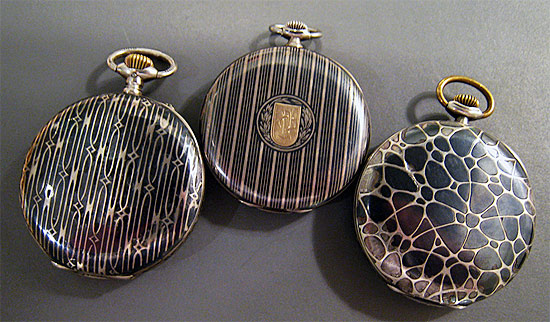At their peak production (early 1900s) pocket watches were available in all imaginable styles and decorations, with all sorts of complications. The price range started from a famous $1 Ingersoll to more common nickel-cased daily wearers, precision railroad timekeepers to fancy gold cased gem studded "Royalty" examples. And on the very top were complicated perpetual calendars, chronographs and repeaters.
And then, there were the really cool and sophisticated, artistic niello pocket watches.

Niello is a black alloy (lead, copper, silver, sulphur and sal ammoniac) which was filled into a chiseled or engraved silver case. The niello paste was then fired. The excess alloy - which was very hard - was then removed with a file, and the remaining surface was then polished.
Being a silver based alloy, it 'fused' perfectly with the silver case, leaving a striking black and white appearance.
Needless to say, engraving a silver case for a niello required both craftsmanship and artistry. Some of the most distinctive, intricate and beautiful Art Nouveau niello cases were produced in early 1900s and I have no doubt that Draper Senior would have a such a piece in his waist coat.
So next time you see a niello pocket watch, don't rush- take your time to study the smooth patterns and immerse yourself in the fascinating world of fine horology.
If you wish to start your pocket watch collection then here are the 3 most important thing to look for:
- go for an example with perfectly preserved niello, but also one with an intriguing pattern
- go for a brand name (Omega for example, or Longines)
- the watch mechanism must be in good working order, the winding system flawless and the
balance wheel unaltered, preferably with original balance staff. And the porcelain dial
intact, free of any hairlines.
Based purely on the pattern, my pick would be wither one on the left or on the right (on above photo) where the middle example would be less desirable because of the crest.
Happy collecting!
No comments:
Post a Comment